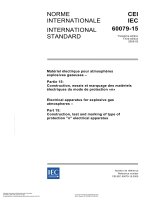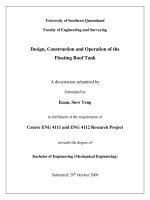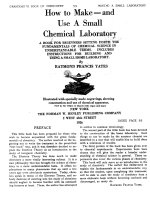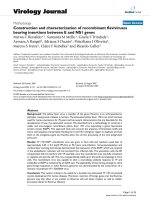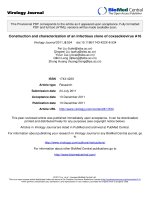Gas Station Construction and Maintenance, Petroleum systems Contractor Nevada and Arizona_6 potx
Bạn đang xem bản rút gọn của tài liệu. Xem và tải ngay bản đầy đủ của tài liệu tại đây (562.56 KB, 13 trang )
Miscellaneous Mechanical Components DOE-HDBK-1018/2-93 REFERENCES
REFERENCES
Babcock & Wilcox, Steam, Its Generations and Use, Babcock & Wilcox Co.
Benson & Whitehouse, Internal Combustion Engines, Pergamon.
Bureau of Naval Personnel, Principles of Naval Engineering, Training Publication
Division, Naval Personnel Program Support Activity, Washington D.C., 1970.
Cheremisinoff, N. P., Fluid Flow, Pumps, Pipes and Channels, Ann Arbor Science.
E.E.U.A., Steam Trapping and Condensate Removal, Constable & Company.
Engineering Service Division, Power Orientation Program, E.I.du Pont de Nemours and
Company, Inc., 1952.
Heat Transfer, Thermodynamics and Fluid Flow Fundamentals, Columbia, MD,
General Physics Corporation, Library of Congress Card #A 326517.
General Physics, Volume IV, Chemistry, Health Physics and Nuclear Instrumentation,
General Physics Corporation.
Marley, Cooling Tower Fundamentals and Applications, The Marley Company.
NUS Training Corporation, Nuclear Energy Training, NUS Corporation, 1977.
Scheel, Gas and Air Compression Machinery, McGraw/Hill.
Stewart, Harry L., Pneumatics & Hydraulics, Theodore Audel & Company.
Westinghouse Technical Manual 1440-C307, SNUPPS, Pressurizer Instructions,
Westinghouse.
Rev. 0 Page vii ME-05
Simpo PDF Merge and Split Unregistered Version -
OBJECTIVES DOE-HDBK-1018/2-93 Miscellaneous Mechanical Components
TERMINAL OBJECTIVE
1.0 Without references, DESCRIBE the purpose, construction, and operation of miscellaneous
mechanical components.
ENABLING OBJECTIVES
1.1 STATE the three common types of air compressors.
1.2 DESCRIBE the basic operation of the following types of air compressors:
a. Reciprocating
b. Centrifugal
c. Rotary
1.3 STATE the reason for using cooling systems in air compressors.
1.4 STATE three hazards associated with pressurized air systems.
1.5 Given the appropriate information, CALCULATE the pressure or force achieved in a
hydraulic piston.
1.6 DESCRIBE the basic operation of a hydraulic system.
1.7 DESCRIBE the basic operation of a boiler.
1.8 IDENTIFY the following components of a typical boiler:
a. Steam drum d. Downcomer
b. Distribution header(s) e. Risers
c. Combustion chamber
1.9 STATE the purpose of cooling towers.
1.10 DESCRIBE the operation of the following types of cooling towers.
a. Forced draft
b. Natural convection
ME-05 Page viii Rev. 0
Simpo PDF Merge and Split Unregistered Version -
Miscellaneous Mechanical Components DOE-HDBK-1018/2-93 OBJECTIVES
ENABLING OBJECTIVES (Cont.)
1.11 STATE the purpose of a demineralizer.
1.12 STATE the four purposes of a pressurizer.
1.13 DEFINE the following terms attributable to a dynamic pressurizer:
a. Spray nozzle c. Outsurge
b. Insurge d. Surge volume
1.14 STATE the purpose and general operation of a steam trap.
1.15 IDENTIFY the following types of steam traps:
a. Ball float steam trap c. Bucket steam trap
b. Bellow steam trap d. Impulse steam trap
1.16 DESCRIBE each of the following types of strainers and filters, including an example of
typical use.
a. Cartridge filters d. Bucket strainer
b. Precoated filters e. Duplex strainer
c. Deep-bed filters
1.17 EXPLAIN the application and operation of a strainer or filter backwash.
Rev. 0 Page ix ME-05
Simpo PDF Merge and Split Unregistered Version -
OBJECTIVES DOE-HDBK-1018/2-93 Miscellaneous Mechanical Components
Intentionally Left Blank
ME-05 Page x Rev. 0
Simpo PDF Merge and Split Unregistered Version -
Miscellaneous Mechanical Components DOE-HDBK-1018/2-93 AIR COMPRESSORS
AIR COMPRESSORS
The purpose of an air compressor is to provide a continuous supply of pressurized
air. This chapter will describe the various types of compressors and their basic
operation.
EO 1.1 STATE the three common types of air compressors.
EO 1.2 DESCRIBE the basic operation of the following types of air
compressors:
a. Reciprocating
b. Centrifugal
c. Rotary
EO 1.3 STATE the reason for using cooling systems in air
compressors.
EO 1.4 STATE three hazards associated with pressurized air systems.
Introduction
Air compressors of various designs are used widely throughout DOE facilities in numerous
applications. Compressed air has numerous uses throughout a facility including the operation of
equipment and portable tools. Three types of designs include reciprocating, rotary, and
centrifugal air compressors.
Reciprocating Compressors
The reciprocating air compressor, illustrated in Figure 1, is the most common design employed
today.
The reciprocating compressor normally consists of the following elements.
a. The compressing element, consisting of air cylinders, heads and pistons, and air
inlet and discharge valves.
b. A system of connecting rods, piston rods, crossheads, and a crankshaft and
flywheel for transmitting the power developed by the driving unit to the air
cylinder piston.
Rev. 0 ME-05
Page 1
Simpo PDF Merge and Split Unregistered Version -
AIR COMPRESSORS DOE-HDBK-1018/2-93 Miscellaneous Mechanical Components
c. A self-contained lubricating system for bearings, gears, and cylinder walls,
Figure 1 Reciprocating Air Compressor
including a reservoir or sump for the lubricating oil, and a pump, or other means
of delivering oil to the various parts. On some compressors a separate force-fed
lubricator is installed to supply oil to the compressor cylinders.
d. A regulation or control system designed to maintain the pressure in the discharge
line and air receiver (storage tank) within a predetermined range of pressure.
e. An unloading system, which operates in conjunction with the regulator, to reduce
or eliminate the load put on the prime mover when starting the unit.
ME-05 Rev. 0
Page 2
Simpo PDF Merge and Split Unregistered Version -
Miscellaneous Mechanical Components DOE-HDBK-1018/2-93 AIR COMPRESSORS
A section of a typical reciprocating single-stage, single-acting compressor cylinder is shown in
Figure 2. Inlet and discharge valves are located in the clearance space and connected through
ports in the cylinder head to the inlet and discharge connections.
During the suction stroke the compressor piston starts its downward stroke and the air under
Figure 2 Single-Acting Air Compressor Cylinder
pressure in the clearance space rapidly expands until the pressure falls below that on the opposite
side of the inlet valve (Figures 2B and 2C). This difference in pressure causes the inlet valve
to open into the cylinder until the piston reaches the bottom of its stroke (Figure 2C).
During the compression stroke the piston starts upward, compression begins, and at point D has
reached the same pressure as the compressor intake. The spring-loaded inlet valve then closes.
As the piston continues upward, air is compressed until the pressure in the cylinder becomes
great enough to open the discharge valve against the pressure of the valve springs and the
pressure of the discharge line (Figure 2E). From this point, to the end of the stroke (Figures 2E
and 2A), the air compressed within the cylinder is discharged at practically constant pressure.
Rev. 0 ME-05
Page 3
Simpo PDF Merge and Split Unregistered Version -
AIR COMPRESSORS DOE-HDBK-1018/2-93 Miscellaneous Mechanical Components
Rotary Compressors
The rotary compressor is adaptable to direct drive by induction motors or multicylinder gasoline
or diesel engines. The units are compact, relatively inexpensive, and require a minimum of
operating attention and maintenance. They occupy a fraction of the space and weight of a
reciprocating machine of equivalent capacity. Rotary compressor units are classified into three
general groups, slide vane-type, lobe-type, and liquid seal ring-type.
The rotary slide vane-type, as illustrated in Figure 3, has longitudinal vanes, sliding radially in
a slotted rotor mounted eccentrically in a cylinder. The centrifugal force carries the sliding
vanes against the cylindrical case with the vanes forming a number of individual longitudinal
cells in the eccentric annulus between the case and rotor. The suction port is located where the
longitudinal cells are largest. The size of each cell is reduced by the eccentricity of the rotor
as the vanes approach the discharge port, thus compressing the air.
Figure 3 Rotary Slide Vane Air Compressor
ME-05 Rev. 0
Page 4
Simpo PDF Merge and Split Unregistered Version -
Miscellaneous Mechanical Components DOE-HDBK-1018/2-93 AIR COMPRESSORS
The rotary lobe-type, illustrated in Figure
Figure 4 Rotary Lobe Air Compressor
4, features two mating lobe-type rotors
mounted in a case. The lobes are gear
driven at close clearance, but without
metal-to-metal contact. The suction to the
unit is located where the cavity made by
the lobes is largest. As the lobes rotate,
the cavity size is reduced, causing
compression of the vapor within. The
compression continues until the discharge
port is reached, at which point the vapor
exits the compressor at a higher pressure.
The rotary liquid seal ring-type,
illustrated in Figure 5, features a forward
inclined, open impeller, in an oblong
cavity filled with liquid. As the impeller
rotates, the centrifugal force causes the
seal liquid to collect at the outer edge of
the oblong cavity. Due to the oblong configuration of the compressor case, large longitudinal
cells are created and reduced to smaller ones. The suction port is positioned where the
longitudinal cells are the largest, and for the discharge port, where they are smallest, thus
causing the vapor within the cell to compress as the rotor rotates. The rotary liquid seal
compressor is frequently used in specialized applications for the compression of extremely
corrosive and exothermic gasses and is commonly used in commercial nuclear plants as a means
of establishing initial condenser vacuum.
Figure 5 Rotary Liquid Seal Ring Air Compressor
Rev. 0 ME-05
Page 5
Simpo PDF Merge and Split Unregistered Version -
AIR COMPRESSORS DOE-HDBK-1018/2-93 Miscellaneous Mechanical Components
Centrifugal Compressors
Figure 6 Simplified Centrifugal Pump
The centrifugal compressor, originally
built to handle only large volumes of low
pressure gas and air (maximum of 40
psig), has been developed to enable it to
move large volumes of gas with discharge
pressures up to 3,500 psig. However,
centrifugal compressors are now most
frequently used for medium volume and
medium pressure air delivery. One
advantage of a centrifugal pump is the
smooth discharge of the compressed air.
The centrifugal force utilized by the
centrifugal compressor is the same force
utilized by the centrifugal pump. The air
particles enter the eye of the impeller,
designated D in Figure 6. As the
impeller rotates, air is thrown against the
casing of the compressor. The air
becomes compressed as more and more air is thrown out to the casing by the impeller blades.
The air is pushed along the path designated A, B, and C in Figure 6. The pressure of the air
is increased as it is pushed along this path. Note in Figure 6 that the impeller blades curve
forward, which is opposite to the backward curve used in typical centrifugal liquid pumps.
Centrifugal compressors can use a variety of blade orientation including both forward and
backward curves as well as other designs.
There may be several stages to a centrifugal air compressor, as in the centrifugal pump, and the
result would be the same; a higher pressure would be produced. The air compressor is used to
create compressed or high pressure air for a variety of uses. Some of its uses are pneumatic
control devices, pneumatic sensors, pneumatic valve operators, pneumatic motors, and starting
air for diesel engines.
Compressor Coolers
The amount of moisture that air can hold is inversely proportional to the pressure of the air. As
the pressure of the air increases, the amount of moisture that air can hold decreases. The amount
of moisture that air can hold is also proportional to the temperature of the air. As the
temperature of the air increases, the amount of moisture it can hold increases. However, the
pressure change of compressed air is larger than the temperature change of the compressed air.
This causes the moisture in the air to condense. Moisture in compressed air systems can cause
serious damage. The condensed moisture can cause corrosion, water hammers, and freeze
damage; therefore, it is important to avoid moisture in compressed air systems. Coolers are used
to minimize the problems caused by heat and moisture in compressed air systems.
ME-05 Rev. 0
Page 6
Simpo PDF Merge and Split Unregistered Version -
Miscellaneous Mechanical Components DOE-HDBK-1018/2-93 AIR COMPRESSORS
Coolers used on the discharge of a compressor are called aftercoolers. Their purpose is to
remove the heat generated during the compression of the air. The decrease in temperature
promotes the condensing of any moisture present in the compressed air. This moisture is
collected in condensate traps that are either automatically or manually drained.
If the compressor is multi-staged, there may be an intercooler, which is usually located after the
first stage discharge and before the second stage suction. The principle of the intercooler is the
same as that of the aftercoolers. The result is drier, cooler, compressed air. The structure of
a particular cooler depends on the pressure and volume of the air it cools. Figure 7 illustrates
a typical compressor air cooler. Air coolers are used because drier compressed air helps prevent
corrosion and cooler compressed air allows more air to be compressed for a set volume.
Figure 7 Compressor Air Cooler
Hazards of Compressed Air
People often lack respect for the power in compressed air because air is so common and is often
viewed as harmless. At sufficient pressures, compressed air can cause serious damage if handled
incorrectly. To minimize the hazards of working with compressed air, all safety precautions
should be followed closely.
Small leaks or breaks in the compressed air system can cause minute particles to be blown at
extremely high speeds. Always wear safety glasses when working in the vicinity of any
compressed air system. Safety goggles are recommended if contact lenses are worn.
Compressors can make an exceptional amount of noise while running. The noise of the
compressor, in addition to the drain valves lifting, creates enough noise to require hearing
protection. The area around compressors should normally be posted as a hearing protection
zone.
Rev. 0 ME-05
Page 7
Simpo PDF Merge and Split Unregistered Version -
AIR COMPRESSORS DOE-HDBK-1018/2-93 Miscellaneous Mechanical Components
Pressurized air can do the same type of damage as pressurized water. Treat all operations on
compressed air systems with the same care taken on liquid systems. Closed valves should be
slowly cracked open and both sides should be allowed to equalize prior to opening the valve
further. Systems being opened for maintenance should always be depressurized before work
begins.
Great care should be taken to keep contaminants from entering air systems. This is especially
true for oil. Oil introduced in an air compressor can be compressed to the point where
detonation takes place in a similar manner as that which occurs in a diesel engine. This
detonation can cause equipment damage and personnel injury.
Summary
The important information in this chapter is summarized below.
Air Compressors Summary
The three common types of air compressors are reciprocating, rotary, and
centrifugal.
The single-stage reciprocating compressor has a piston that moves
downward during the suction stroke, expanding the air in the cylinder. The
expanding air causes pressure in the cylinder to drop. When the pressure
falls below the pressure on the other side of the inlet valve, the valve
opens and allows air in until the pressure equalizes across the inlet valve.
The piston bottoms out and then begins a compression stroke. The upward
movement of the piston compresses the air in the cylinder, causing the
pressure across the inlet valve to equalize and the inlet valve to reseat.
The piston continues to compress air during the remainder of the upward
stroke until the cylinder pressure is great enough to open the discharge
valve against the valve spring pressure. Once the discharge valve is open,
the air compressed in the cylinder is discharged until the piston completes
the stroke.
ME-05 Rev. 0
Page 8
Simpo PDF Merge and Split Unregistered Version -
Miscellaneous Mechanical Components DOE-HDBK-1018/2-93 AIR COMPRESSORS
Air Compressors Summary (Cont.)
The centrifugal force utilized by the centrifugal compressors is the same
force utilized by the centrifugal pumps. The air particles enter the eye of
the impeller. As the impeller rotates, air is thrown against the casing of
the compressor. The air becomes compressed as more and more air is
thrown out to the casing by the impeller blades. The air is pushed along
the path on the inner wall of the casing. The pressure of the air is
increased as it is pushed along this path. There could be several stages to
a centrifugal air compressor just as in the centrifugal pump, resulting in
higher pressure.
Rotary compressors are driven by a direct drive that rotates a mechanism
(impellers, vanes, or lobes) that compresses the air being pumped. The
actual compression of the air takes place due either to centrifugal forces
or a diminishing air space as the impellers rotate.
Cooling systems are required in compressed air systems to remove any
heat added by the compression. The advantages to cooling the compressed
air are that cool air takes less space and holds less moisture. This reduces
corrosion and allows more air to be compressed into a given volume.
Hazards associated with compressed air are similar to hazards of any high
pressure system. Three general hazards include the following.
Small leaks or breaks can cause minute particles to be blown at speeds
high enough to cause damage. Goggles or safety glasses should be worn
when working around compressed gas.
The compressors, especially larger ones, can be quite noisy when running.
The cycling of automatic drain valves contributes noise as well. Hearing
protection should be worn around compressors.
Pressure swings may cause system damage. Closed valves in a
compressed air system should be slowly cracked open and the pressure
should be allowed to equalize prior to opening the valve further. Systems
should be depressurized prior to opening for maintenance. Oil should be
kept out of air systems to prevent possible explosions.
Rev. 0 ME-05
Page 9
Simpo PDF Merge and Split Unregistered Version -
